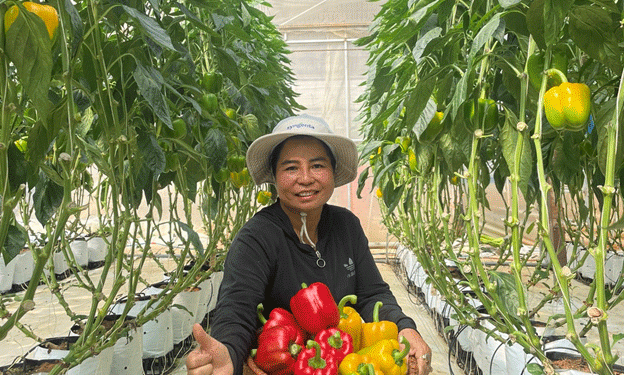Bell pepper cultivation in Lâm Đồng, Vietnam, is evolving rapidly, driven by the adoption of high-tech farming techniques and the strategic selection of resilient, high-yielding seed varieties. Farmers in the region are using modern agricultural practices to enhance both the productivity and quality of their crops, ensuring stable incomes and expanding potential export opportunities.
High-Tech Farming: A Path to Consistent High Yields
Farmers like Nguyễn Thị Lương in Lâm Hà district are leading the way by implementing advanced farming models across their bell pepper fields. Lương’s 1-hectare greenhouse utilizes a drip irrigation system on a substrate base, along with Integrated Pest Management (IPM), which reduces pest damage while minimizing environmental and health impacts.
Lương highlights the significant benefits of automation: “With an automated irrigation system controlled via my phone, I save considerable time and water. The IPM approach also ensures my bell peppers are of the highest quality, which guarantees stable prices and consistent sales.”
Similarly, farmer Kiều Oanh, also from Lâm Hà, has been growing bell peppers in greenhouses for three years and has achieved superior results compared to other crops. “Greenhouse cultivation reduces the negative effects of harsh weather and pest infestations. I’ve chosen strong, disease-resistant seed varieties, which has resulted in vigorous plant growth and consistently high yields,” Oanh shared.
Oanh’s crops produce an average of 5 kilograms of bell peppers per plant, with large, evenly shaped fruits that are crisp and durable. These qualities make her peppers highly desirable to traders, who have signed contracts to purchase her produce season after season.
Seed Selection: The Foundation for Optimal Yield
In addition to modern farming techniques, the selection of high-quality seeds plays a crucial role in achieving robust harvests. In Lâm Đồng, two varieties stand out for their superior performance: Bokken Red Bell Pepper and Kaamos Yellow Bell Pepper.
Nguyễn Văn Hải, another successful bell pepper farmer, explained, “Compared to other varieties, Bokken and Kaamos yield 10-20% more. These seeds produce strong, disease-resistant plants, which reduces both labor and production costs while minimizing plant losses.”
Oanh, who grows both Bokken and Kaamos varieties, added: “Bokken has a lower-growing plant, which makes it easier to care for, while Kaamos peppers are firm, long-lasting, and popular with traders. On average, these varieties outperform others by around 15%.”
Bokken and Kaamos, developed by Syngenta, were specifically chosen for Vietnam’s growing conditions and market demands. They meet high standards for fruit quality and yield, while also featuring resistance to common diseases like powdery mildew and viruses. These traits make them ideal for IPM farming models, helping farmers adapt to modern agricultural techniques while ensuring healthy, resilient crops.
Superior Seed Varieties for Bell Pepper Cultivation
- Bokken Red Bell Pepper (F1 Hybrid): This variety offers continuous fruiting with high disease resistance, especially against powdery mildew. The fruits are evenly sized, bright red, with thick, crisp flesh and a sweet flavor.
- Kaamos Yellow Bell Pepper (F1 Hybrid): Kaamos produces sturdy plants with strong resistance to powdery mildew and viruses like Tm:0-3 and TSWV. The peppers are firm and thick-fleshed, weighing 250-300 grams each, and maintain their quality through rapid color change and long shelf life.
Lâm Đồng’s bell pepper farmers are reaping the benefits of combining high-tech farming techniques with superior seed selection. By using automated irrigation systems, IPM strategies, and disease-resistant seed varieties, farmers have significantly improved both their yields and the quality of their produce. This approach not only stabilizes income for local growers but also enhances their potential for expanding into export markets. As the demand for high-quality, sustainably grown bell peppers increases, Lâm Đồng farmers are well-positioned to capitalize on these opportunities.










